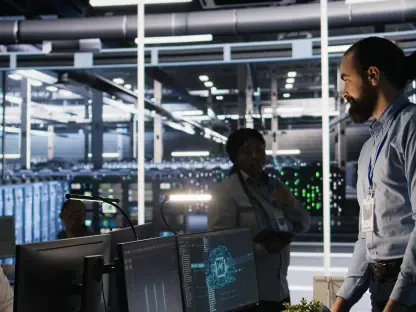The rise in cybersecurity threats targeting critical infrastructures has underscored the urgency for operators and policymakers to enhance defense strategies. These sophisticated attacks often blur the lines between legitimate activities and malicious actions, making detection and defense exceedingly challenging. With critical infrastructures such as water and power utilities being particularly vulnerable, the stakes could not be higher. The consequences of a successful attack can include operational disruptions and the permanent corruption or destruction of crucial data and systems.
Pervasiveness of Cyberattacks
Recent reports have highlighted an alarming increase in cyberattacks on critical infrastructure operators in both the US and UK. In the past year alone, a significant number of these operators have faced multiple attacks that led to major disruptions. Data from Semperis indicates that 62% of these operators have been attacked, with 80% experiencing more than one incident. These attacks do not just disrupt operations temporarily but often result in long-term damage, including permanent corruption or loss of vital data and systems.
The frequency of these cyberattacks is a stark reminder of the vulnerability of critical infrastructures to digital threats. The constant barrage of attacks has forced operators to remain on high alert, dedicating significant resources to cybersecurity measures. These efforts, however, are often insufficient against highly sophisticated threats, which continue to evolve rapidly. The ability to identify and neutralize these threats before they cause irreversible damage remains a significant challenge for infrastructure operators.
Nation-State Sponsored Attacks
A large portion of these cyber threats can be traced back to nation-state actors. In particular, countries such as China, Iran, North Korea, and Russia have been identified as leading sources of these sophisticated attacks. Experts believe that the actual figure of nation-state sponsored cyber threats might be higher than the reported 59%, as many incidents go undetected or are misattributed. These threats are particularly worrisome due to the extensive resources and advanced techniques these actors possess.
The involvement of nation-state actors in cyber threats against critical infrastructure raises the stakes significantly. These attackers have access to state resources, including funding, technology, and expertise, making them formidable adversaries. The asymmetrical nature of this warfare places immense pressure on local infrastructure operators, who often lack the means to defend against such well-resourced threats. The sophisticated tactics employed by nation-state actors demand a coordinated and robust defense strategy at both the local and national levels.
Unawareness and Vulnerability
Despite the high frequency of cyberattacks, a considerable portion of utility operators remain unaware of the threats posed to their systems. Data suggests that 38% of utilities believe they have not been targeted, which likely indicates a lack of proper monitoring and detection capabilities. This lack of awareness translates into a significant vulnerability, as unprepared systems are easy targets for cybercriminals employing advanced techniques.
The vulnerability of these utilities is further exacerbated by gaps in preparedness. Many operators lack the necessary resources, expertise, and infrastructure to mount an effective defense against sophisticated cyberattacks. This unpreparedness often results in delayed responses to cyber incidents, allowing attackers ample time to cause significant damage. Addressing these gaps is crucial for enhancing the resilience of critical infrastructure against cyber threats.
Living off the Land Technique
Nation-state hackers frequently employ a tactic known as “Living off the Land,” which involves using legitimate tools to infiltrate and operate within targeted systems. This technique allows hackers to blend in with normal system processes, making it exceedingly difficult to detect malicious activities. By leveraging existing software and tools, attackers can minimize the chances of detection and extend the duration of their presence within compromised systems.
The “Living off the Land” technique poses a unique challenge for cybersecurity experts. Traditional detection methods often focus on identifying unfamiliar or suspicious software, but this approach falls short when attackers use legitimate tools. Consequently, advanced monitoring and analysis techniques are required to discern between genuine and malicious activities. The ability to detect and respond to these subtle threats is essential for maintaining the integrity and security of critical infrastructure.
Challenges for Local Facilities
Local water and power utilities often face significant challenges in defending against cyber threats. Limited expertise, skills, and financial resources create a disparity that makes it difficult for these facilities to mount an adequate defense. Sean Deuby of Semperis aptly describes this situation as the definition of asymmetrical warfare, with local facilities struggling to fend off well-resourced and highly sophisticated attackers.
The challenges faced by local utilities are further compounded by the complexity of their systems. Many of these facilities manage extensive and interconnected networks, which are vulnerable to a variety of entry points for attackers. The lack of specialized cybersecurity personnel and tools makes it difficult to monitor and secure these networks effectively. Addressing these challenges requires targeted support and resources to ensure that local utilities can defend against cyber threats effectively.
Impact on Critical Infrastructure
Several high-profile cases have underscored the severity of cyber threats to critical infrastructure. For example, Chinese state-sponsored hackers known as Volt Typhoon infiltrated the US electric grid, causing disruptions that lasted for nearly a year. Such incidents highlight the devastating potential of cyberattacks on essential services, demonstrating the need for robust security measures to protect critical infrastructure.
The impact of these attacks extends beyond immediate operational disruptions. Long-term consequences can include damage to equipment, financial losses, and compromised safety protocols. The reliance on critical infrastructure for everyday activities underscores the importance of maintaining its security. Lessons learned from past incidents must inform future defense strategies to mitigate the risks associated with cyber threats.
Need for Legislation and Collaboration
To address the vulnerabilities and challenges faced by critical infrastructure, legislative support and collaborative strategies are essential. Proposed bills such as the Rural Water System Disaster Preparedness and Assistance Act and the Cybersecurity for Rural Water Systems Act aim to provide resources and support for better preparedness. These legislative measures focus on enhancing the resilience of critical infrastructures through targeted funding and initiatives.
Collaboration between various stakeholders, including government agencies, private sector entities, and industry experts, is crucial for developing a comprehensive defense strategy. Establishing strong partnerships and information-sharing mechanisms can improve the overall effectiveness of cybersecurity efforts. By working together, stakeholders can pool resources, share knowledge, and coordinate responses to cyber threats, thereby strengthening the security of critical infrastructure.
Whole-of-State Cybersecurity Strategy
Implementing a whole-of-state cybersecurity strategy can significantly enhance protection measures for critical infrastructure. This approach promotes information sharing and strong partnerships between different government levels and the private sector. Examples from states like Texas and cities like New York illustrate proactive steps toward establishing coordinated state-level cyber commands and enhanced security protocols.
A whole-of-state strategy involves creating integrated cybersecurity frameworks that align local, state, and federal efforts. By fostering collaboration and communication, such strategies can ensure a unified and efficient response to cyber threats. Additionally, continuous training, awareness programs, and investments in advanced security technologies are essential components of this comprehensive approach. The success of a whole-of-state strategy lies in its ability to adapt to evolving cyber threats and to maintain resilient defense mechanisms.
Stakeholders’ Perspectives
The increasing frequency of cybersecurity threats targeting critical infrastructures has highlighted the need for operators and policymakers to bolster their defense mechanisms. These advanced and sophisticated cyberattacks often blur the lines between legitimate activities and malicious actions, making it incredibly difficult to detect and defend against them. Critical infrastructures such as water and power utilities are particularly susceptible, elevating the stakes to an all-time high. A successful cyberattack on these systems can lead to severe consequences, including operational disruptions and the potential permanent corruption or destruction of vital data and systems.
Given the crucial role that these infrastructures play in daily life and national security, the urgency to establish and enhance robust security measures cannot be overstated. Attacks can not only cripple essential services but also have a domino effect, impacting other sectors and potentially causing widespread chaos. Continuous advancements in technology and the evolving nature of cyber threats demand that defense strategies be constantly updated and refined. Policymakers must collaborate with industry experts to develop comprehensive approaches that can effectively safeguard these essential systems from cyber threats. The stakes are incredibly high, and the repercussions of inaction could be catastrophic. Thus, it is imperative to take proactive measures to protect our critical infrastructures before it is too late.









